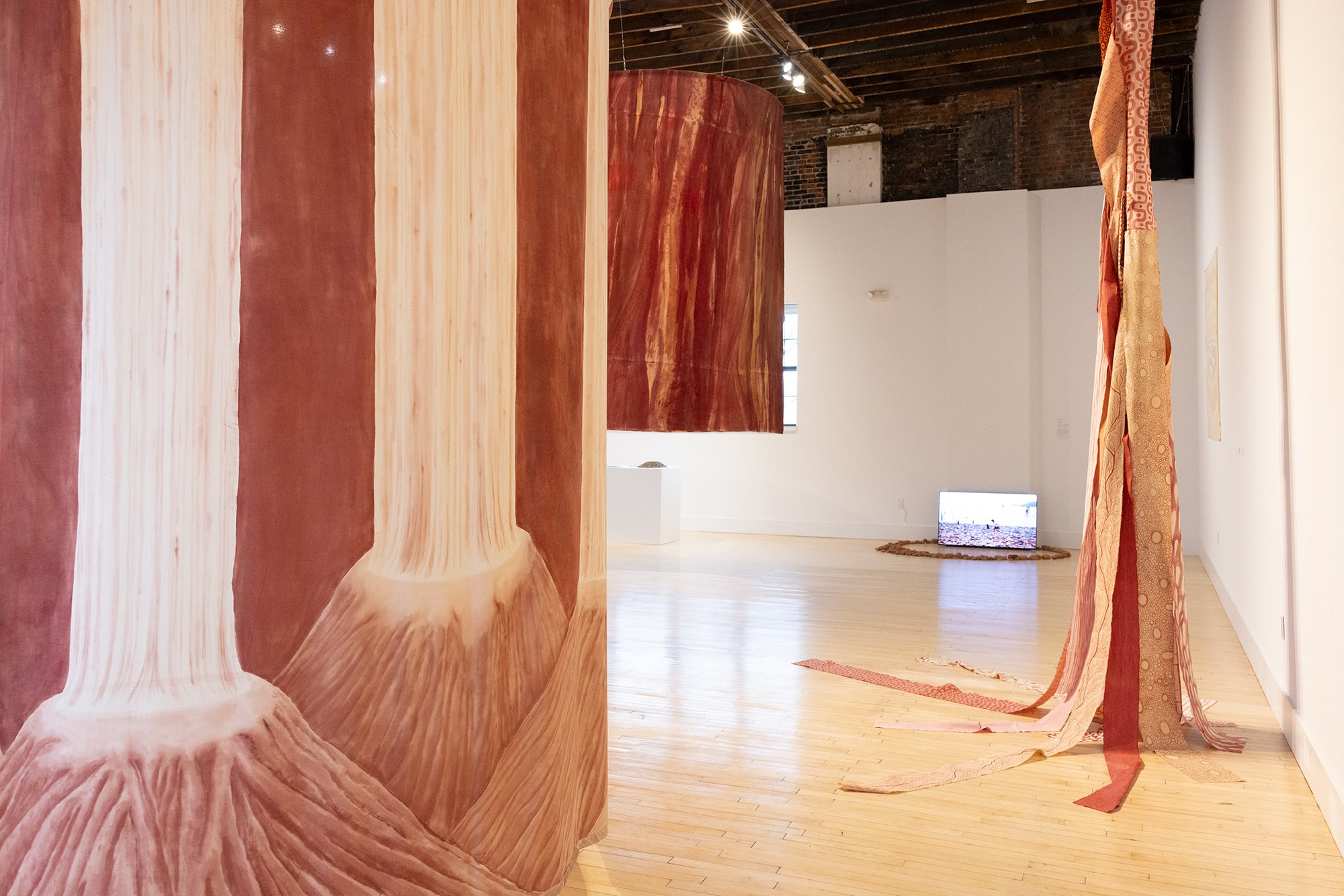Exhibition
March 9 – May 5, 2024
KinoSaito Art Center
Verplanck, NY
Bel Falleiros:
Navel-Knot // Root-Rise
CLICK HERE to view the exhibition.
River Valley Arts Collective is pleased to present Bel Falleiros: Navel-Knot // Root-Rise, organized in partnership with KinoSaito Art Center. Curated by Jess Wilcox, the exhibition embraces the symbolic potential of the artist’s engagement with Earth-centered elements: fired terra cotta, plant and earth pigments, and sound that Falleiros incorporates into a series of works that celebrate the majesty and complexity of landforms and forests, and the continuity of water and life flowing through them.
The show’s anchor work titled Vermelho como Brasil [As Red as Brazil] explores the history, vibrancy, and endangerment of the artist's place of birth and the slow growing native trees that gave the colonial state its name. Falleiros pays homage to these trees with a hanging painting installation of semi-circular form that approximates the diameter of a recently discovered six hundred year-old Brazilwood tree. The painting’s vermillion pigment is made from the sawdust byproduct of Brazilwood violin bows, demonstrating the artist’s ethical sourcing and her concern for this limited earth resource.
Rounded forms also appear in Falleiros’ Navels series that explore sacred geologic and human made landforms that range from the geometries of indigenous architecture to volcanoes and sink-hole caves known as cenotes. The Earth’s Navel, the supposed center of the world, manifests as a recurring element in both terracotta (fired earth) and painting (water-based earth pigment) works and serves as a reminder of art’s enmeshment in ecological systems and sacred places.
Falleiros’ Ripple series highlights the movement of water through atmosphere and matter, uniting land, plants, humans and the Earth in the interconnected ecological system of life. The sound work To Ripple with Water imbues the exhibition space with a restorative mood and vocals that parallel the Earth’s own reparative forces.
Finding significance in both the material and metaphorical ripple effects in the world, several of the artist’s ceramic sculptures adopt the form of concentric circles reminiscent of the shapes caused by a drop on still water. The video work titled Ripple Stories (Haverstraw) explores the unifying nature of water and its relationship to clay by capturing Falleiros performing a symbolic act on the shore of Haverstraw, New York. Located just across the Hudson River and south of KinoSaito, the town, once a capital of U.S. brickmaking in the 19th Century, was devastated by a landslide due to the brick industry’s over extraction of clay from the land. In a memorializing gesture, Falleiros acknowledges this past by arranging eroded abandoned bricks in a series of concentric circles, allowing the estuary tide to obscure her small landmark.
Lastly, the artist contextualizes and unites the multiple interests explored in the exhibition by sharing her thinking and working process. Occupying a gallery wall, Falleiros displays material samples, artist notes and sketches inspired by her studio research. Sustained knowledge building and committed engagement with Indigenous communities nurtures Falleios’ holistic artistic output. This network, visualized here, can be understood as the roots of her practice.
Bel Falleiros is a Brazilian artist whose practice focuses on place and belonging. Starting in her hometown of São Paulo, she has worked to understand how contemporary constructed landscapes (mis)represent the diverse layers of presence that constitute a place and how this affects its inhabitants. Walking is core to Falleiros’ practice and played a significant role in her first solo exhibition at CAIXA Cultural São Paulo in 2014. Since arriving in the United States, she has produced public land artworks at Pecos National Park, New Mexico (2016); at Burnside Farm, Detroit , IL (2017); in collaboration with Tewa Women United as part of the Santa Fe Art Institute’s Equal Justice Residency (2018); and as part of the MONUMENTS NOW’ show at Socrates Sculpture Park, NY (2020). Recently, Falleiros was featured in Under the ashes, ember at MAM, São Paulo (2022), the New York Latin American Art Triennial Abya Yala: Structural Origins (2022), and a solo exhibition Floresta de Pulsares (Forest of Pulses) at Wave Hill, in Bronx, New York (2023).
This exhibition is on view at KinoSaito Art Center located at 115 7th Street, Verplanck, New York. Hours: Friday–Sunday, 10am–5pm. For more information please visit kinosaito.org.
KinoSaito is a nonprofit interdisciplinary art center established to extend the collaborative and experimental practices of the Japanese American abstract painter and avant-garde theater designer, Kikuo Saito (1939–2016). Located in the newly renovated former St. Patrick’s Catholic School in Verplanck, NY, the center, which had been Saito’s studio, houses two large art galleries, a multipurpose theater/dance/performance space, two studios for a rotating roster of resident artists, a classroom for arts education and public programs, a café, and a bountiful garden.














